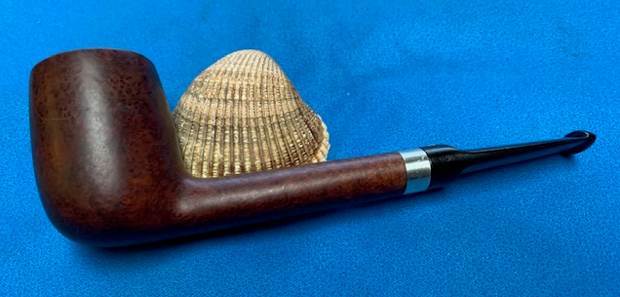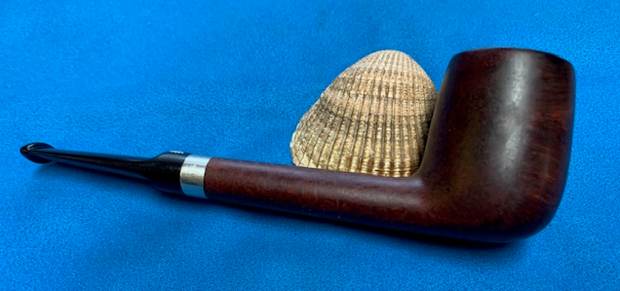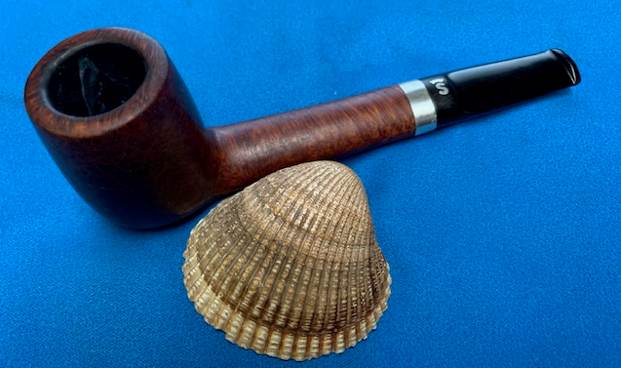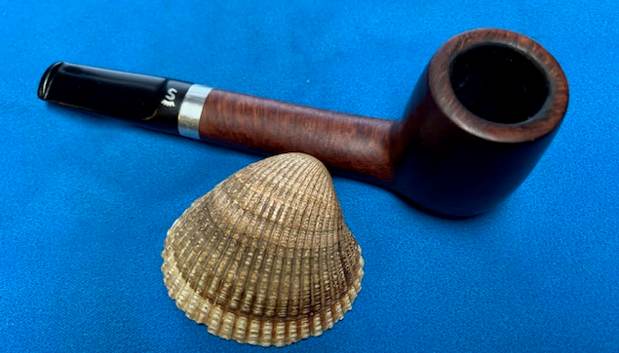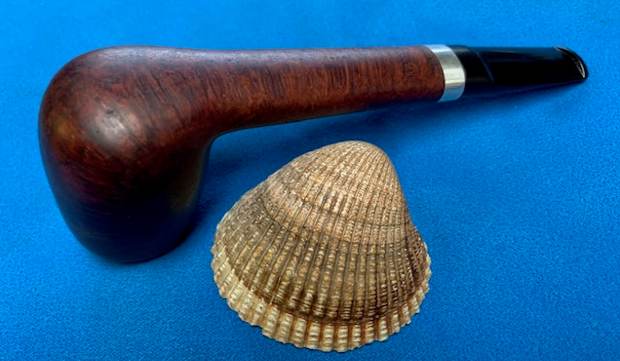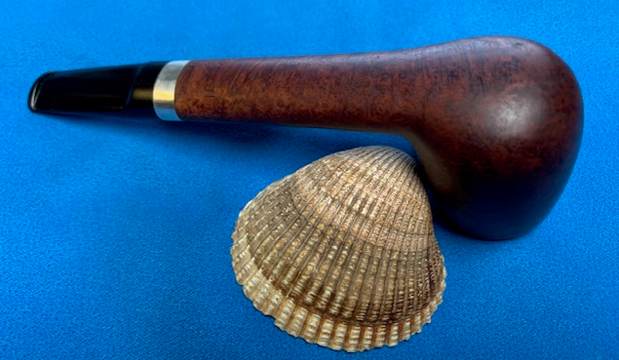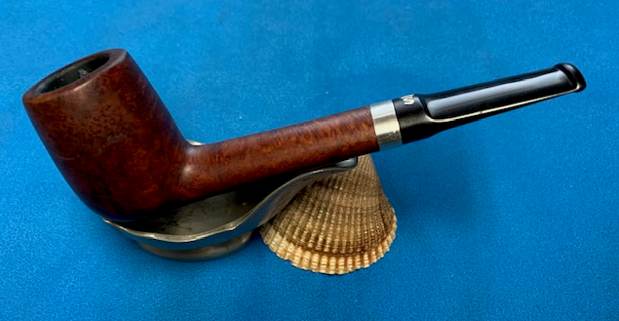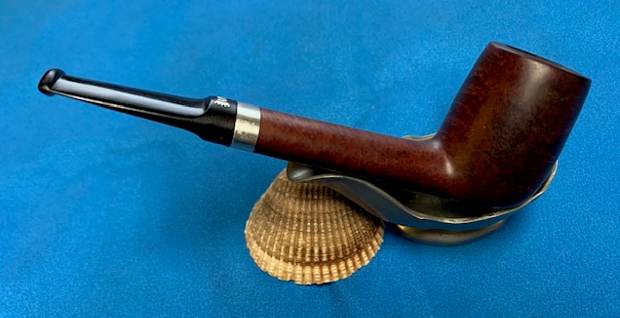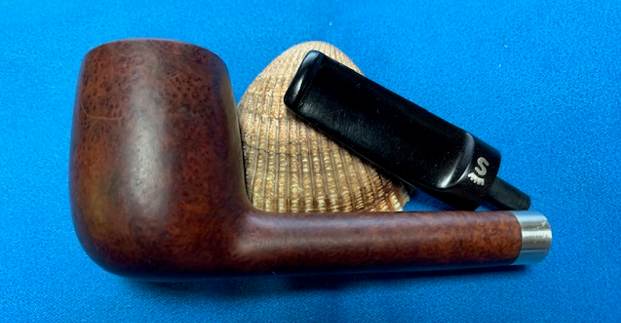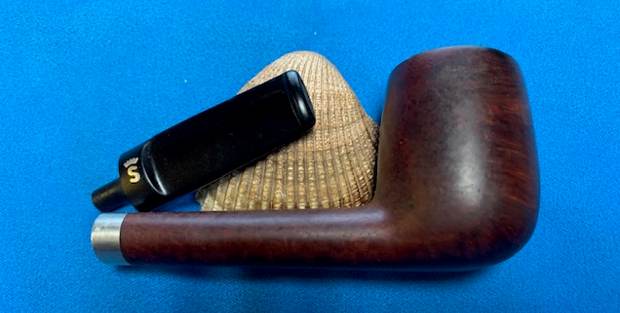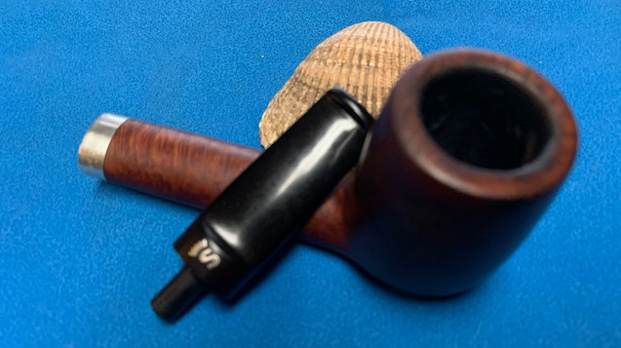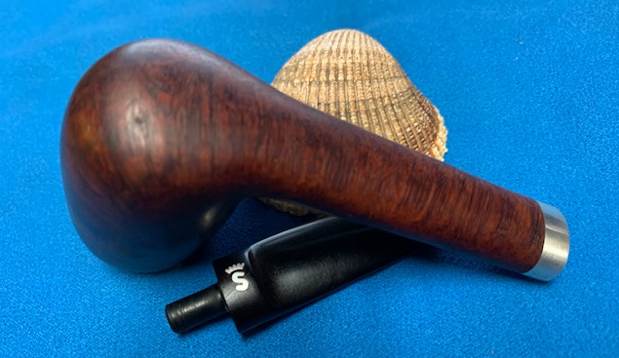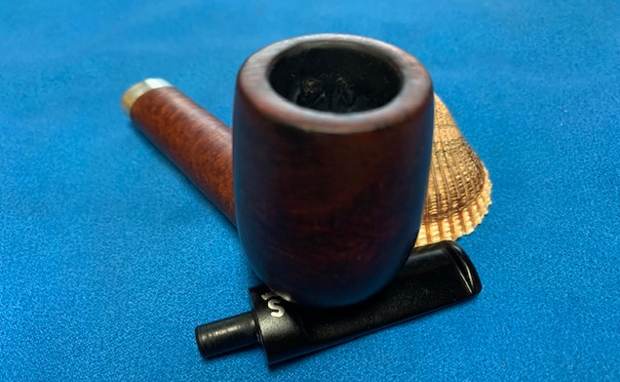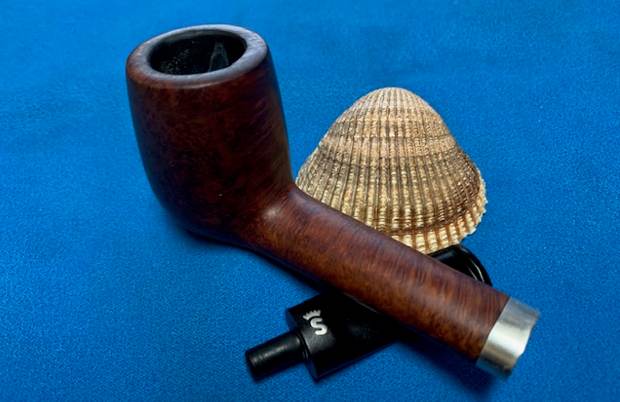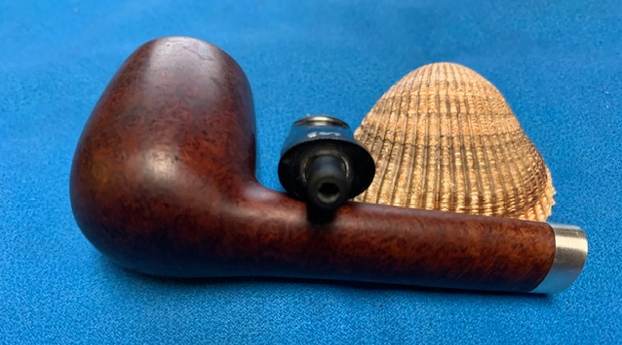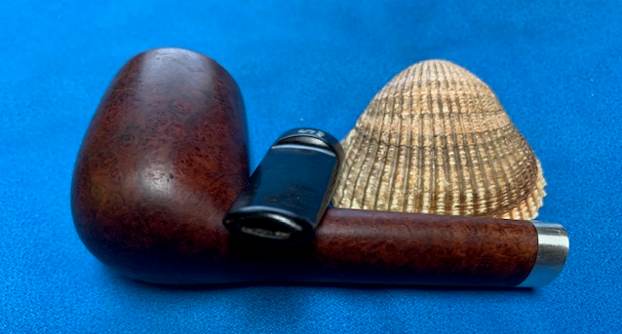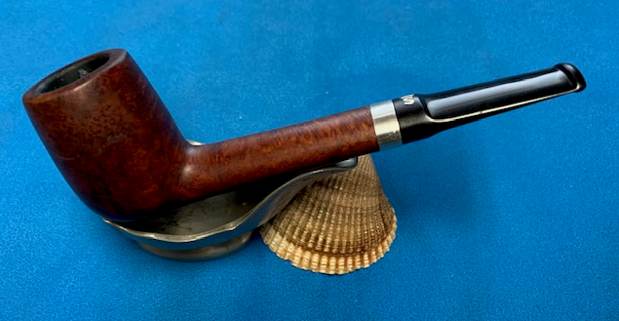Blog by Steve Laug
It is a rainy Saturday for me here in Vancouver so I decided to work on another one that was purchased on 01/10/2023 in a lot of pipes that came to us from Copenhagen, Denmark. This is a oval shank Canadian with a smooth finish and a silver band on the shank. It is another Made in Denmark Stanwell. The smooth finish on this pipe, around the bowl and shank has a mix of grain highlighted by the reddish brown stain. The pipe is stamped on the underside of the shank near the stem/shank junction and reads STANWELL [over] Royal De Luxe [over] Made In Denmark. On the underside of the center of the shank it has the shape number 148 stamped. On the silver band there was a 925 stamp on the right side giving the quality of silver in the band. The pipe was a well used pipe when Jeff received it. There was dust and grime ground into the finish which was worn thin on the sides of the bowl. The mixture of brown stains highlights some beautiful grain under the dirt. The bowl was moderately caked and there was a light overflow of lava on the smooth rim top. The inner edge looked worn but okay. There was a trough on the bottom of the bowl that had been worn with repeated use of pipe cleaners. It was not terribly deep but bothersome looking and if left alone could further wear through the heel of the bowl. The saddle stem is vulcanite and was dirty, oxidized and had light tooth marks, chatter and scratches on both sides ahead of the button and on the button itself. There is a Silver Crown S logo inlaid on the topside of the saddle stem. Jeff took photos of the pipe before he started his clean up work on it. 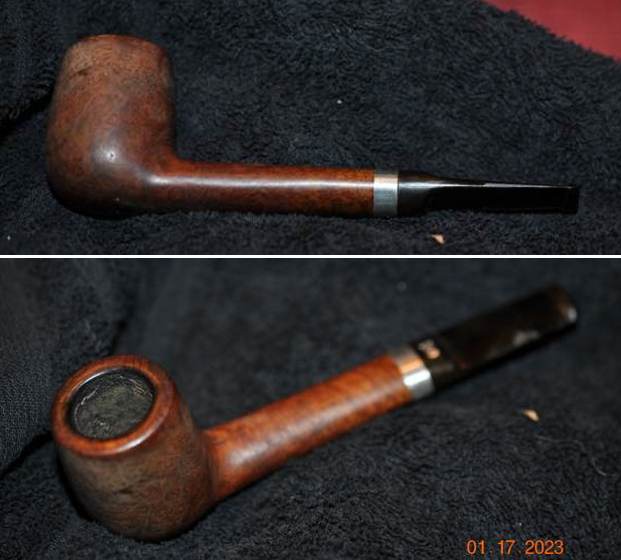 He took photos of the bowl and rim top to show what they looked like before his clean up. You can see the scratches in the smooth rim top. The inner edge also shows some damage. He also took some of the stem to show the condition of both sides.
He took photos of the bowl and rim top to show what they looked like before his clean up. You can see the scratches in the smooth rim top. The inner edge also shows some damage. He also took some of the stem to show the condition of both sides. 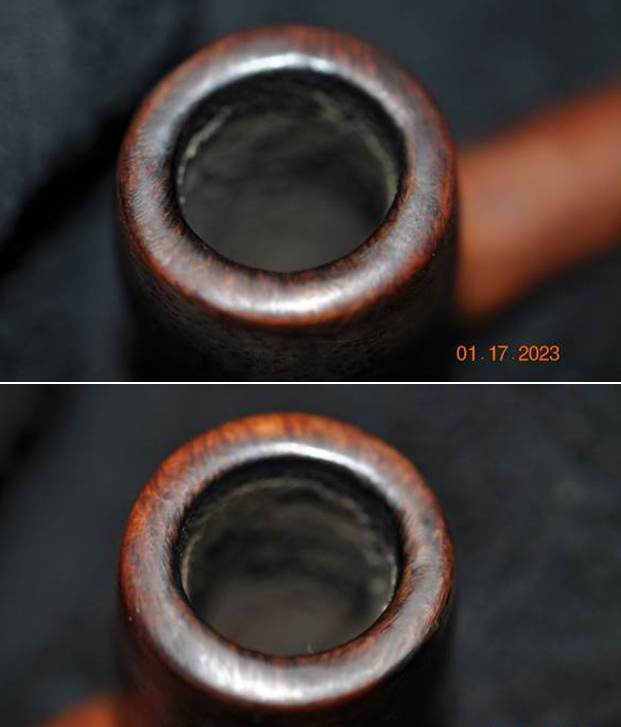
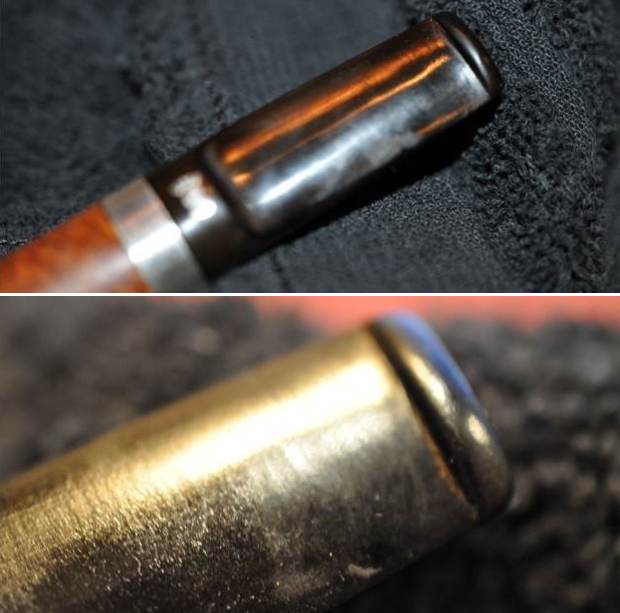
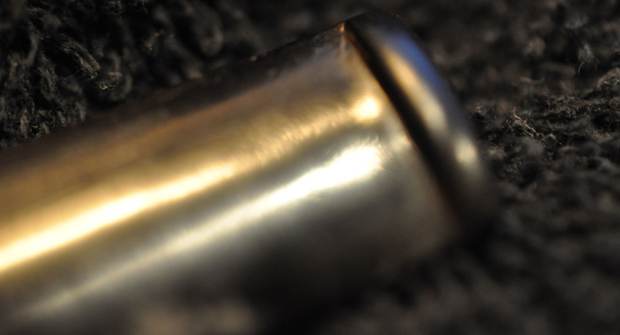 The photos of the sides and heel of the bowl show the faded stain and the grain around the bowl and shank. The mixture of brown stains adds depth finish on the pipe. Even under the grime it is a real beauty. You can also see the swirls in the acrylic shank extension.
The photos of the sides and heel of the bowl show the faded stain and the grain around the bowl and shank. The mixture of brown stains adds depth finish on the pipe. Even under the grime it is a real beauty. You can also see the swirls in the acrylic shank extension.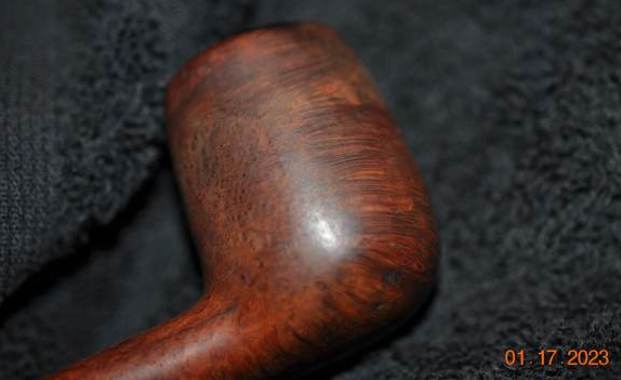
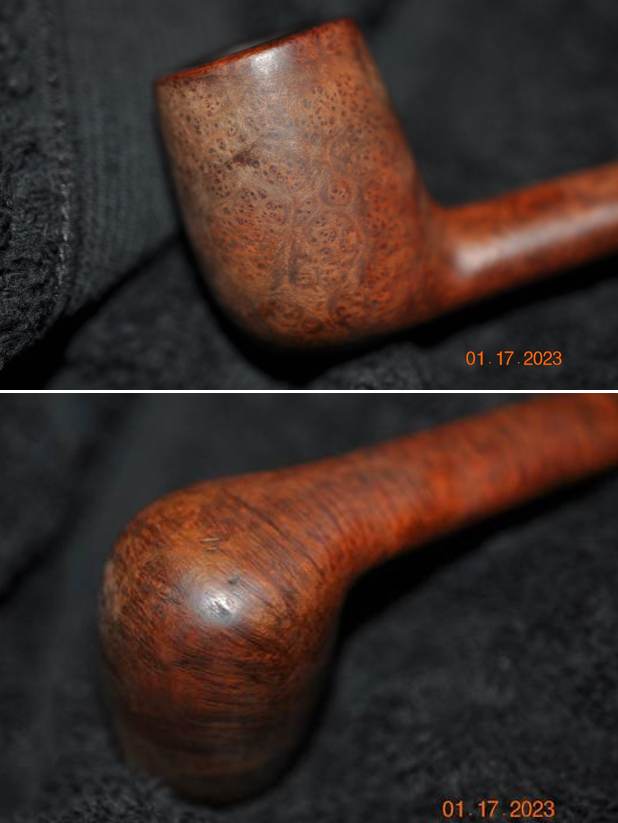 The stamping on this one was around the bamboo horizontally and is shown in the photo below. It is clear and readable as noted above. The second photo shows the white stamped crown S on the stem side.
The stamping on this one was around the bamboo horizontally and is shown in the photo below. It is clear and readable as noted above. The second photo shows the white stamped crown S on the stem side. 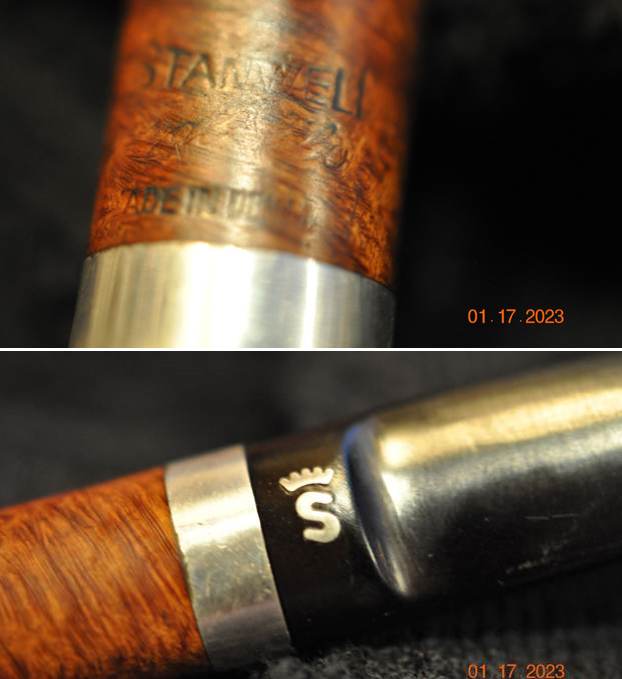 Before I started my work on the pipe I wanted to see if I could find any information that would help me get a sense of the line. I turned to Pipephil to see if there was any listing on the Royal Deluxe Line (http://pipephil.eu/logos/en/logo-stanwell.html). There was nothing listed.
Before I started my work on the pipe I wanted to see if I could find any information that would help me get a sense of the line. I turned to Pipephil to see if there was any listing on the Royal Deluxe Line (http://pipephil.eu/logos/en/logo-stanwell.html). There was nothing listed.
I then turned to Pipedia (https://pipedia.org/wiki/Stanwell) for more information. The article is great and gives a lot of history on the brand. There were also links to a shape article by Bas Stevens that I originally published on rebornpipes. I looked up the 148 shape number to see who had designed that shape (https://pipedia.org/wiki/Stanwell_Shape_Numbers_and_Designers). I quote the information on shape 148.
- Canadian, short saddle mouthpiece by Jess Chonowitsch.
Now it was time to work on the pipe.
Jeff had thoroughly cleaned up the pipe. He reamed the pipe with a PipNet Pipe Reamer and cleaned up the remnants with a Savinelli Fitsall Pipe Knife. He scrubbed the bowl with undiluted Murphy’s Oil Soap with a tooth brush. He rinsed it under running warm water to remove the soap and grime. He cleaned out the inside of the shank and the airway in the stem with alcohol, cotton swabs and pipe cleaners. He scrubbed the exterior of the stem with Soft Scrub to remove the grime and calcification. He soaked the stem in Before & After Deoxidizer and rinsed it off with warm water. The pipe looked very good when it arrived here in Vancouver.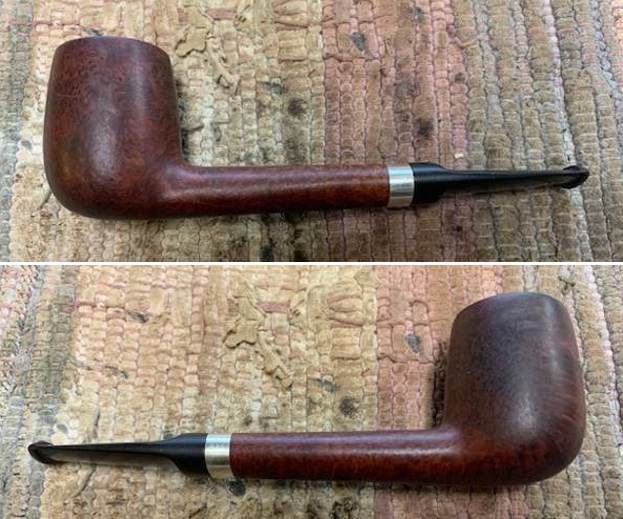
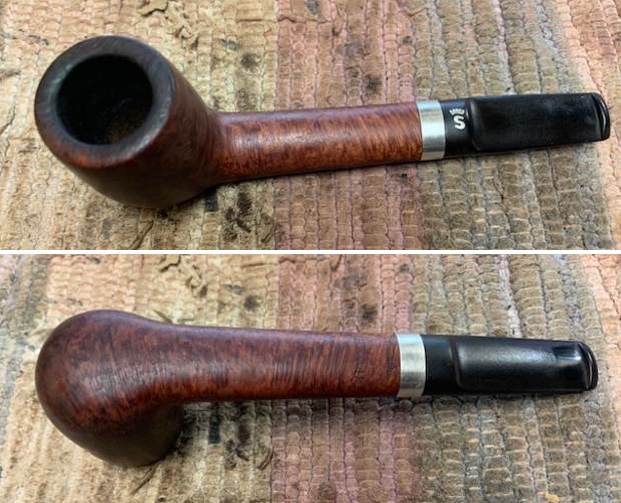 I took close up photos of the bowl, rim and the stem. You can see the damage on rim top and inner edge. The bowl is quite clean inside with trough worn into the bottom of the bowl visible in the photo below. The vulcanite saddle stem is in good condition with light tooth marks and some chatter as noted above.
I took close up photos of the bowl, rim and the stem. You can see the damage on rim top and inner edge. The bowl is quite clean inside with trough worn into the bottom of the bowl visible in the photo below. The vulcanite saddle stem is in good condition with light tooth marks and some chatter as noted above. 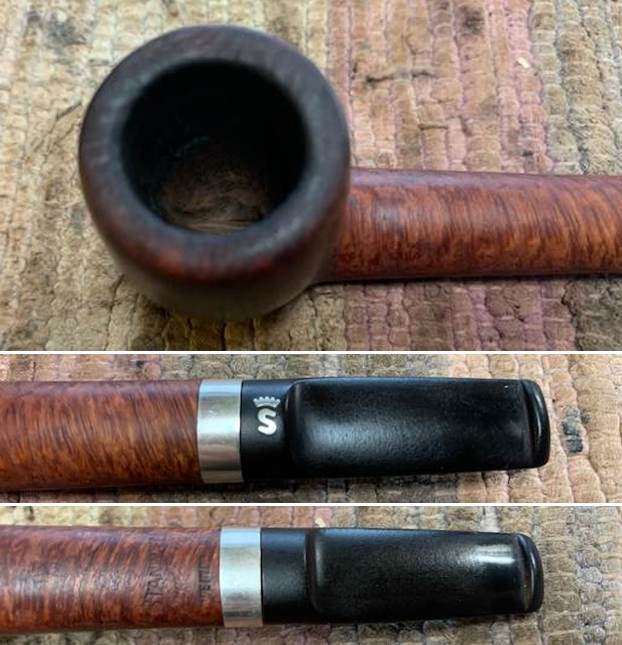 I took photo of the stamping on the underside of the shank. It is faint but readable as noted.
I took photo of the stamping on the underside of the shank. It is faint but readable as noted. 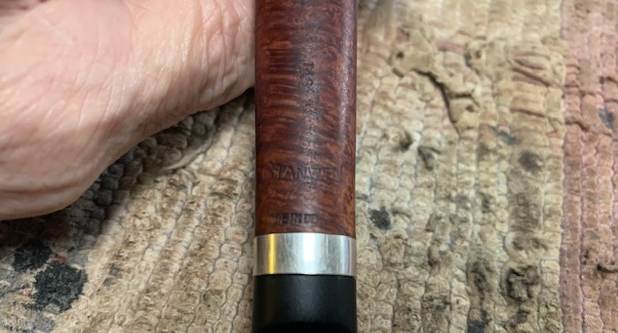 I removed the stem from the shank and took a photo to give a sense of the proportions of the pipe. The briar is quite beautiful and the dark and medium stains really make it stand out.
I removed the stem from the shank and took a photo to give a sense of the proportions of the pipe. The briar is quite beautiful and the dark and medium stains really make it stand out.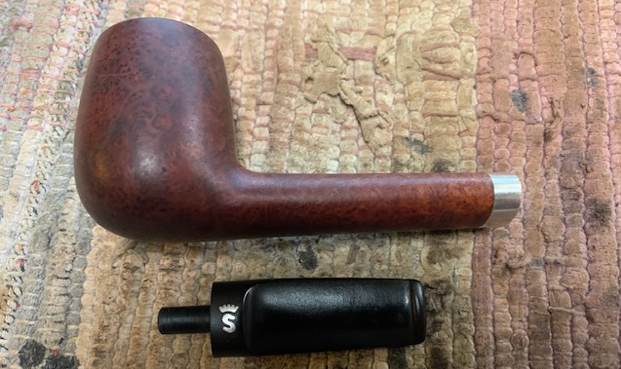 I started my work on the pipe by dealing with the trough in the bottom of the bowl. I decided to use a mixture of Plaster of Paris and water to make a thick paste to fill in the trough in the bottom and up the front side of the bowl. I put a pipe cleaner in the airway to keep it from clogging. I applied the plaster in the bowl with a dental spatula, tamped it down with a tamper and cleaned up the sides and edges of the repair with folded pipe cleaners.
I started my work on the pipe by dealing with the trough in the bottom of the bowl. I decided to use a mixture of Plaster of Paris and water to make a thick paste to fill in the trough in the bottom and up the front side of the bowl. I put a pipe cleaner in the airway to keep it from clogging. I applied the plaster in the bowl with a dental spatula, tamped it down with a tamper and cleaned up the sides and edges of the repair with folded pipe cleaners.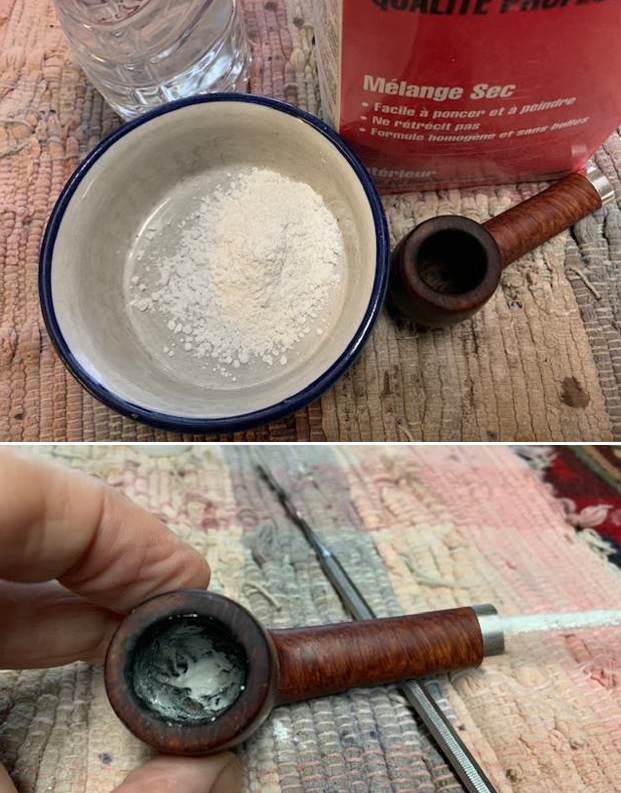
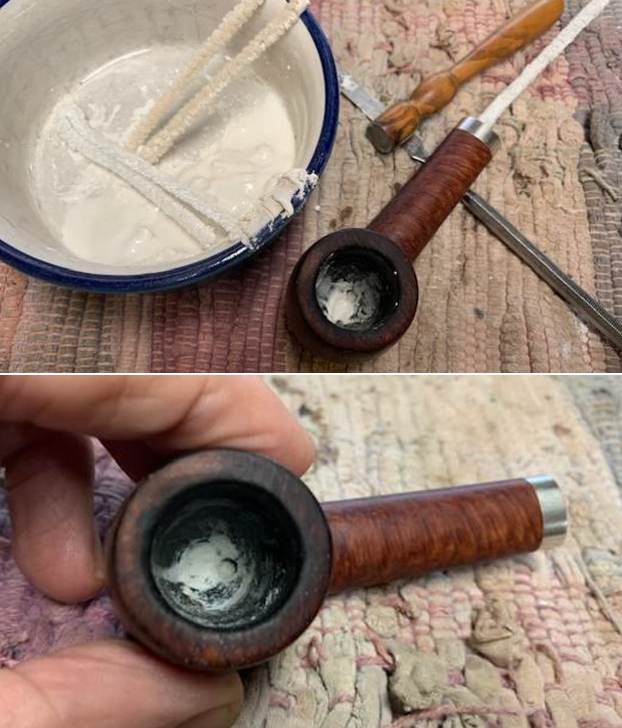 While the Plaster repair cured, I worked on the damage to the inner edge and the rim top with a folded piece of 220 grit sandpaper to bring the edge back into round and smooth out the scratches on the top. By the end it looked much better.
While the Plaster repair cured, I worked on the damage to the inner edge and the rim top with a folded piece of 220 grit sandpaper to bring the edge back into round and smooth out the scratches on the top. By the end it looked much better.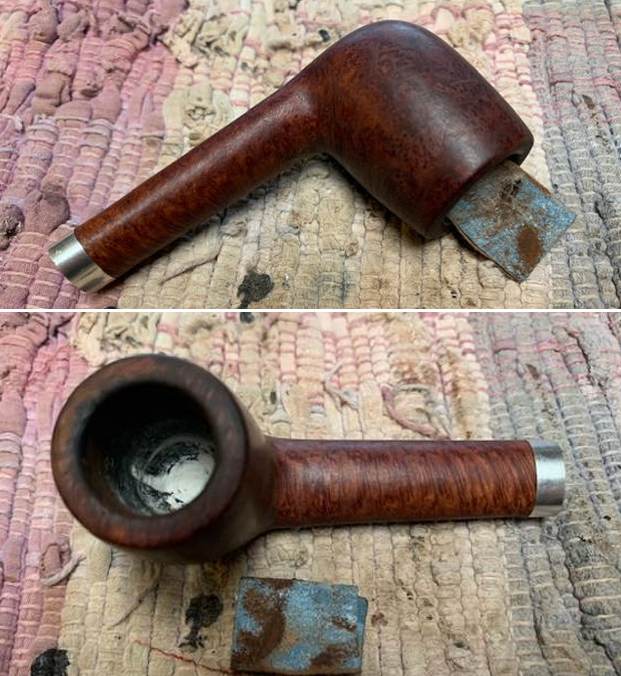 I wiped down the excess Plaster of Paris with qtips until all that remained was in the bottom and front of the bowl. I let the inside of the bowl repair cure. Once cured I would need to give it a slight bowl coating.
I wiped down the excess Plaster of Paris with qtips until all that remained was in the bottom and front of the bowl. I let the inside of the bowl repair cure. Once cured I would need to give it a slight bowl coating.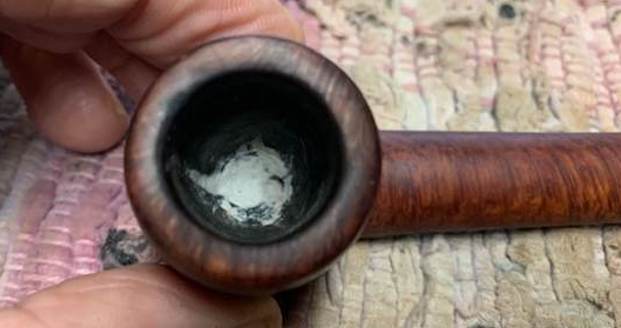 I polished the bowl and shank with micromesh sanding pads – dry sanding with 1500-12000 grit pads. I wiped the bowl down after each pad to remove the grit. The bowl began to take on a rich shine. It is a beauty.
I polished the bowl and shank with micromesh sanding pads – dry sanding with 1500-12000 grit pads. I wiped the bowl down after each pad to remove the grit. The bowl began to take on a rich shine. It is a beauty. 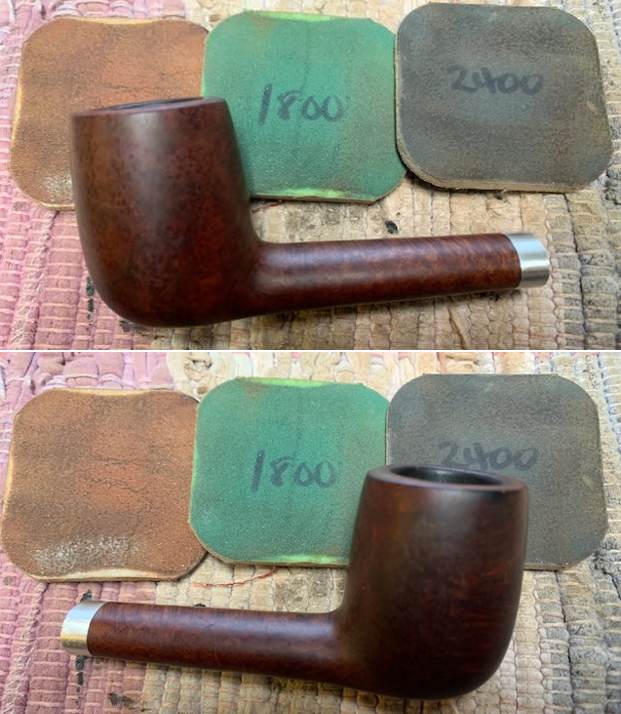
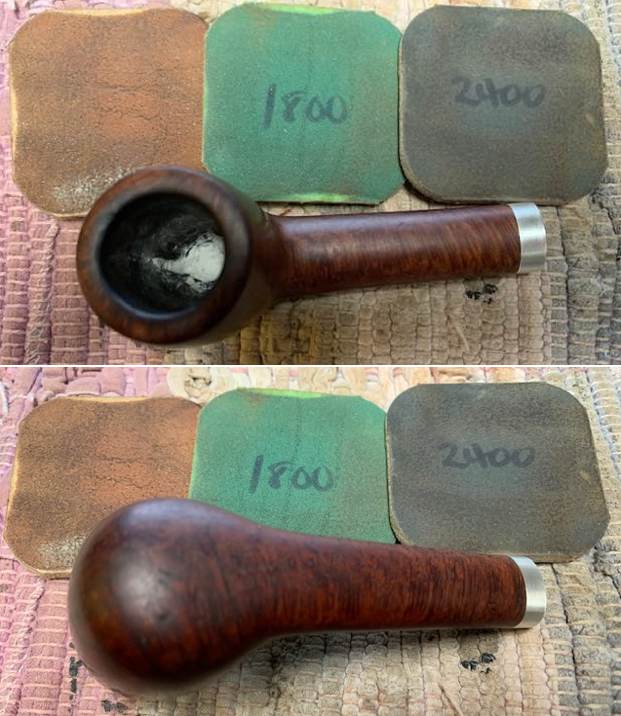
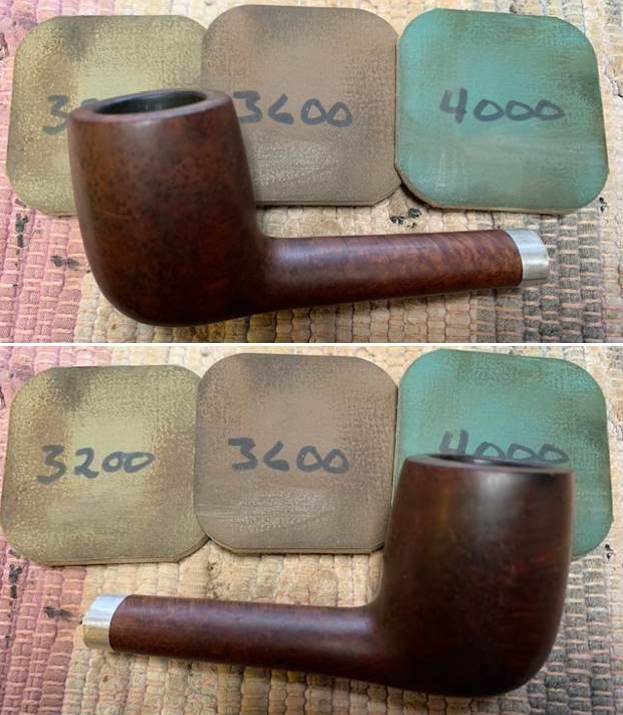
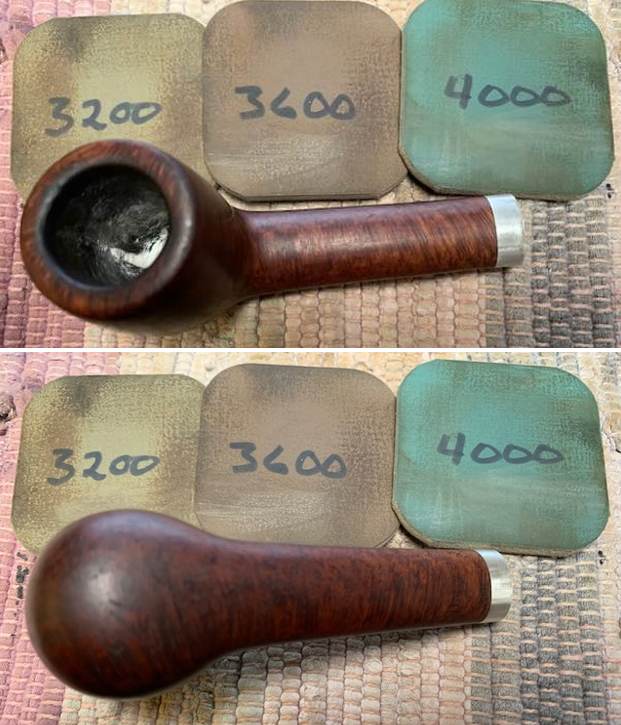
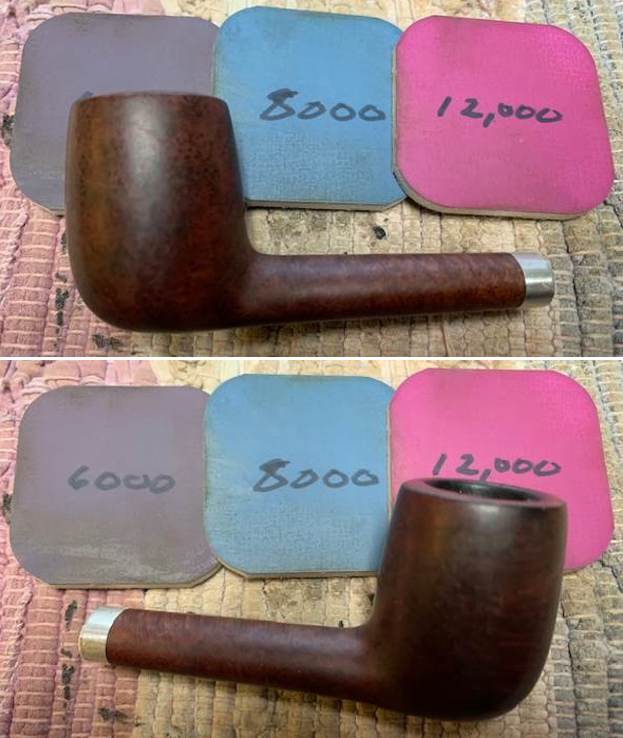
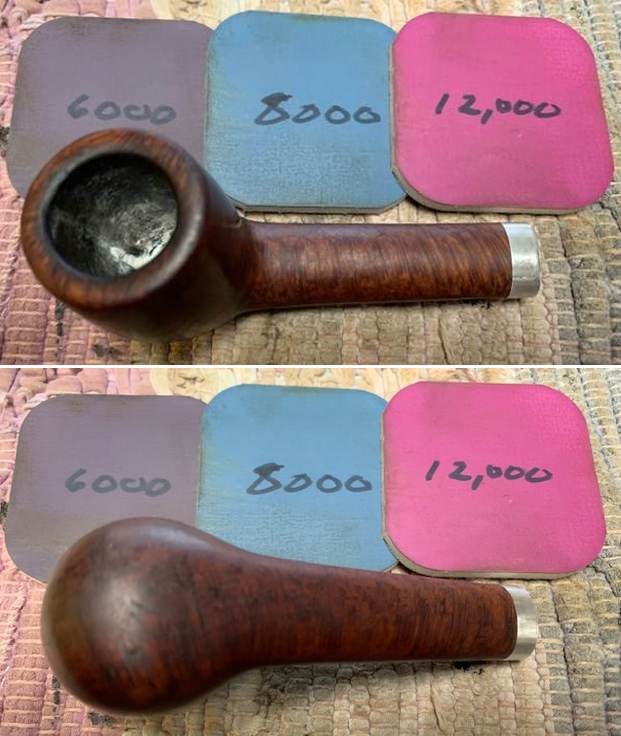 I rubbed the bowl down with Before & After Restoration Balm. I worked it into the briar with my finger tips. I let it sit for 10 minutes and the Balm did its magic. It enlivens, cleans and preserves the briar. It certainly brought this bowl back to life. I buffed it off with a clean cloth and took the following photos.
I rubbed the bowl down with Before & After Restoration Balm. I worked it into the briar with my finger tips. I let it sit for 10 minutes and the Balm did its magic. It enlivens, cleans and preserves the briar. It certainly brought this bowl back to life. I buffed it off with a clean cloth and took the following photos. 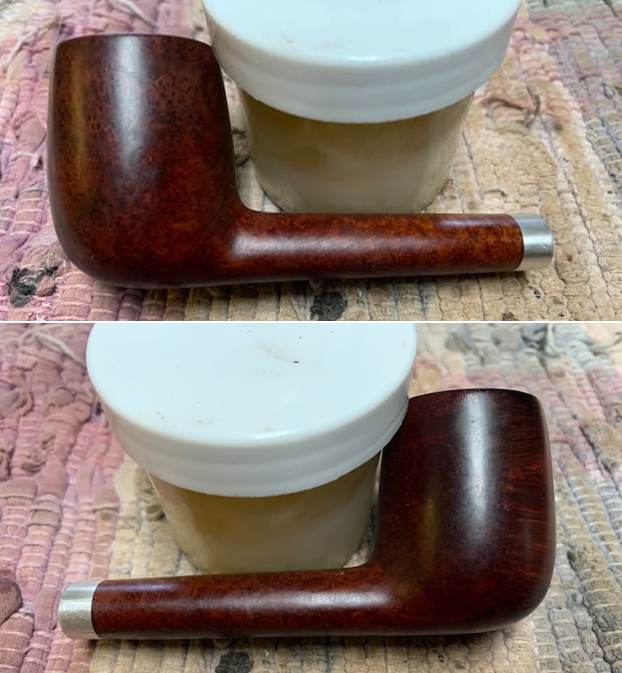
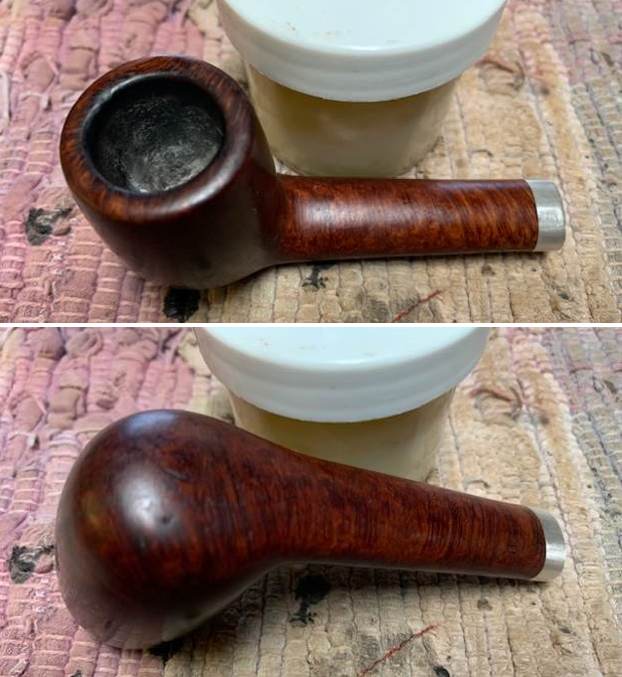
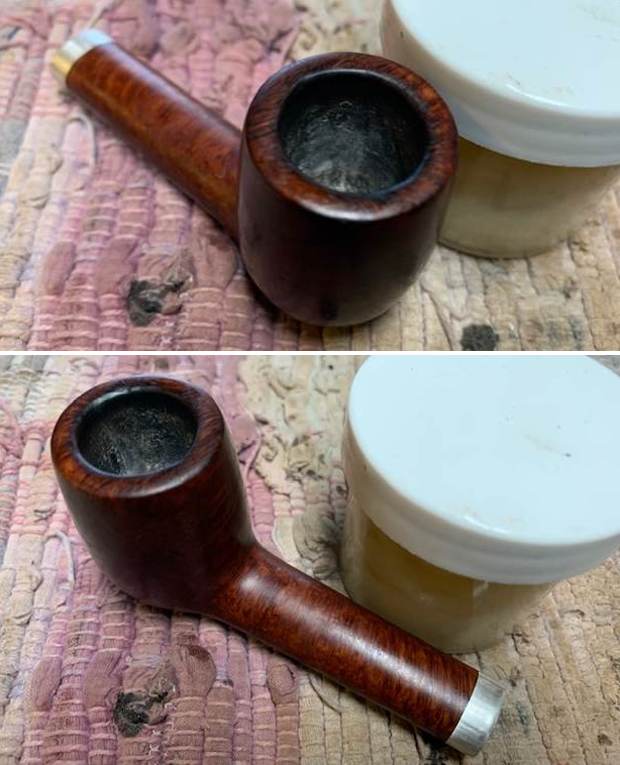 I coated the bowl with a mixture of sour cream and charcoal powder. The bowl coating is applied over the Plaster of Paris repair on the bottom of the bowl and the walls. I used a dental spatula to mix it up and put a pipe cleaner in the airway to keep it from clogging. I used a folded pipe cleaner to paint it on the bowl bottom and walls. Once finished I set it aside to dry.
I coated the bowl with a mixture of sour cream and charcoal powder. The bowl coating is applied over the Plaster of Paris repair on the bottom of the bowl and the walls. I used a dental spatula to mix it up and put a pipe cleaner in the airway to keep it from clogging. I used a folded pipe cleaner to paint it on the bowl bottom and walls. Once finished I set it aside to dry.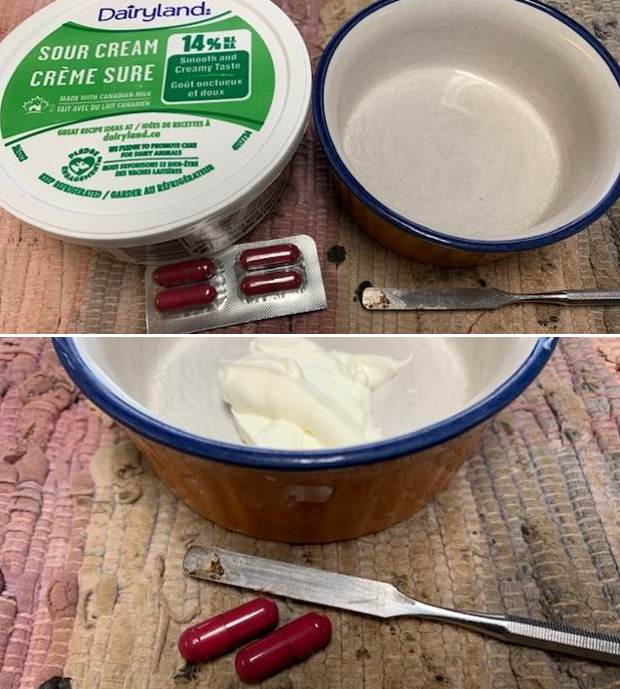
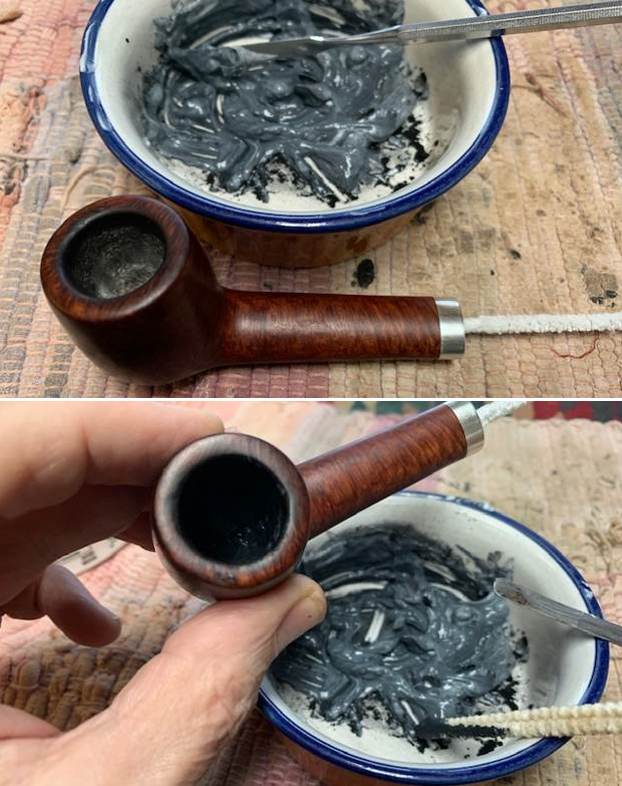
 I set the bowl aside and turned my attention to the stem. I polished the stem with micromesh sanding pads – 1500-12000 grit pads. I wiped it down with a damp cloth after each sanding pad. I used Before & After Pipe Polish – both Fine and Extra Fine to further polish the stem.
I set the bowl aside and turned my attention to the stem. I polished the stem with micromesh sanding pads – 1500-12000 grit pads. I wiped it down with a damp cloth after each sanding pad. I used Before & After Pipe Polish – both Fine and Extra Fine to further polish the stem.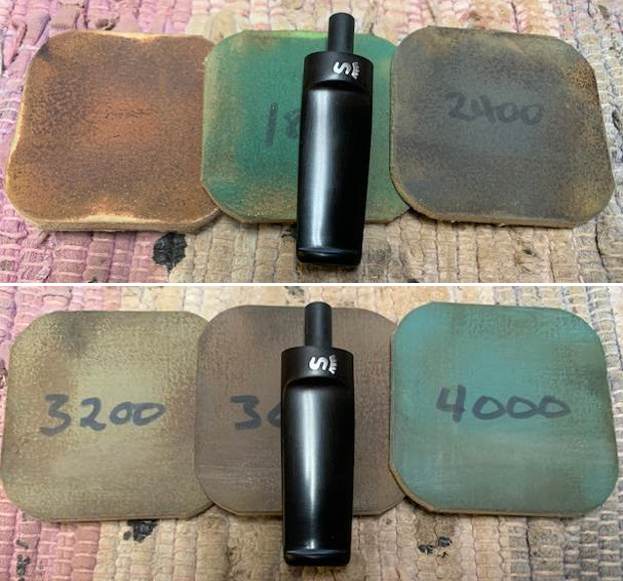
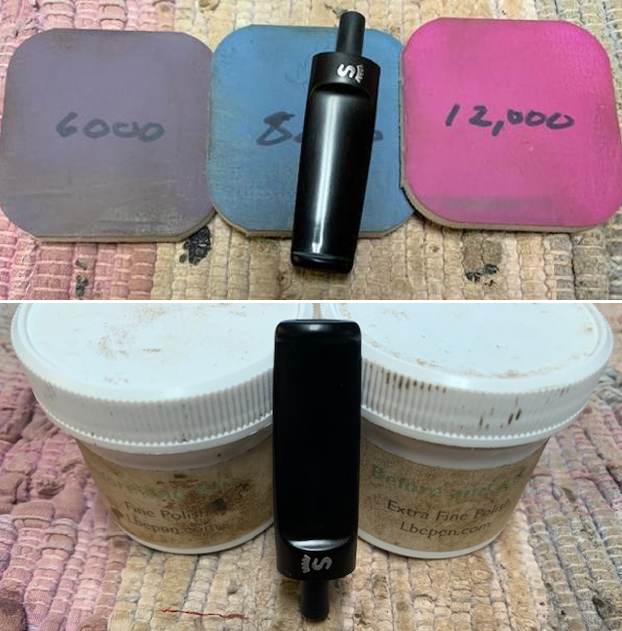 This Stanwell Royal De Luxe 148 Canadian with a vulcanite saddle stem is a great looking pipe now that it has been restored. The mix of stains once cleaned up really highlights the grain and the polished sandblast finish is stunning. I put the stem back on the bowl and carefully buffed the pipe with Blue Diamond on the buffing wheel. I gave the bowl and the stem multiple coats of carnauba wax on the buffing wheel and followed that by buffing the entire pipe with a clean buffing pad. I hand buffed the pipe with a microfiber cloth to deepen the shine. The finished Stanwell Royal Deluxe 149 Canadian fits nicely in the hand and feels great. Give the finished pipe a look in the photos below. The dimensions of the pipe are Length: 5 ½ inches, Height: 1 ¾ inches, Outside diameter of the bowl: 1 1/8 inch, Chamber diameter: ¾ of an inch. The weight of the pipe is 36 grams / 1.27 ounces. I will be adding the pipe to the Danish Pipe Makers Section of the rebornpipes store. If you are interested in purchasing this pipe send me a message or an email. Thanks for reading this blog and my reflections on the pipe while I worked on it.
This Stanwell Royal De Luxe 148 Canadian with a vulcanite saddle stem is a great looking pipe now that it has been restored. The mix of stains once cleaned up really highlights the grain and the polished sandblast finish is stunning. I put the stem back on the bowl and carefully buffed the pipe with Blue Diamond on the buffing wheel. I gave the bowl and the stem multiple coats of carnauba wax on the buffing wheel and followed that by buffing the entire pipe with a clean buffing pad. I hand buffed the pipe with a microfiber cloth to deepen the shine. The finished Stanwell Royal Deluxe 149 Canadian fits nicely in the hand and feels great. Give the finished pipe a look in the photos below. The dimensions of the pipe are Length: 5 ½ inches, Height: 1 ¾ inches, Outside diameter of the bowl: 1 1/8 inch, Chamber diameter: ¾ of an inch. The weight of the pipe is 36 grams / 1.27 ounces. I will be adding the pipe to the Danish Pipe Makers Section of the rebornpipes store. If you are interested in purchasing this pipe send me a message or an email. Thanks for reading this blog and my reflections on the pipe while I worked on it. 